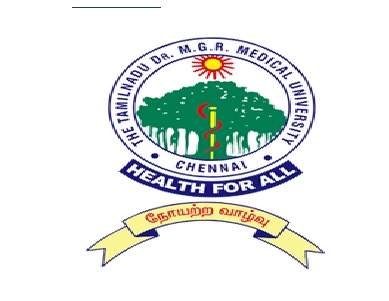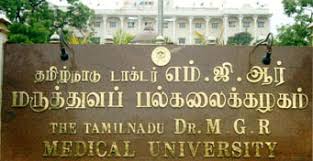TNMGRMU General Pathology & Haematology Second MBBS Question Bank
Name of the University : The Tamilnadu Dr. M.G.R. Medical University
Degree : Second M.B.B.S
Subject Code/Name : 4063 General Pathology & Haematology
Paper : V
Document Type : Question Bank
Website : web.tnmgrmu.ac.in
Download Model/Sample Question Paper :
2008-2014 : https://www.pdfquestion.in/uploads/we…7-524063LA.pdf
2005-2008 : https://www.pdfquestion.in/uploads/we…7-524063KU.pdf
TNMGRMU General Pathology & Haematology Question Bank
Degree : Second M.B.B.S
Related / Similar Question Paper :
TNMGRMU MBBS Applied Microbiology Question Bank
August 2008
I. Essay Questions : (2 x 15 = 30)
1. What is Metastasis. What are the different pathways of spread? Write in detail about one of the pathways

2. Define anemia. Discuss etiopathogenesis with blood and bone morrow picture in iron deficiency anemia.
II. Write Short notes on : (10 x 5 = 50)
1. Free radicals.
2. Wilm’s tumour.
3. Klinefelter syndrome.
4. Oncogenic viruses.
5. Rhinosporidiosis.
6. Ricketts.
7. Fine Needle Aspiration Cytology
8. Leukemoid reaction.
9. Idiopathic thrombocytopenic purpura.
10. Erythrocyte sedimentation rate.
III. Short Answer Questions : (10 x 2 = 20)
1. What are the different types of necrosis?
2. Mention 4 factors influencing wound healing.
3. Fate of thrombi.
4. Enumerate 4 types of chromosomal rearrangements.
5. Mention 2 Examples of tumor suppressor genes.
6. Mention any 4 childhood malignancies.
7. What are red cell indices?
8. Blood picture in magaloblastic anemia.
9. Mention important investigations necessary for diagnosis of Hemophilia.
10. Define Leukemia.

February 2009
I. Essay Questions : (2 x 15 = 30)
1. Define and classify oedema? Discuss Aetio-Pathogenesis and pathology of various types of oedema with examples?.
2. 40 years male H/o chronic fatigue, weight loss since 6 months. O/E pallor, marked splenomegaly+, laboratory report shows Hb 10 GM%, TC 215000/CMM. Platelets 4 laks/cmm. Answer the following :
a) What is your diagnosis?
b) What is common genetic abnormality?
c) Blood and Bone Marrow findings to confirm your diagnosis?
d) Prognosis of the condition?
II. Write Short notes on : (10 x 5 = 50)
1. Chemical mediators of acute inflammation.
2. Thrombo-embolism.
3. Pathological calcification.
4. Trisomy – 21.
5. Immune complex hypersensitivity (Type III) reactions.
6. Laboratory diagnosis of cancer.
7. Von-Willebrand’s disease.
8. Haemolytic disease of newborn.
9. Grading and staging of tumors.
10. Automatic tissue processor.
III. Short Answer Questions : (10 x 2 = 20)
1. Difference between exudates and transudate.
2. Microscopic picture of acute appendicitis.
3. Mast cells.
4. Mention four neuclear changes in Necrosis.
5. Significance of casts in urine.
6. Anti-Coagulants.
7. Mention four indications of bone marrow aspiration.
8. Reticulocyte count.
9. Henoch – Schonlein purpura.
10. Gross appearance of Mycetoma foot.
August 2009
I. Essay Questions : (2 x 15 = 30)
1. Define shock, enumerate types of shock and discuss pathogenesis and morphological changes in shock.
2. Mention Oncogenic viruses. Describe Oncogenesis by human papilloma virus.
II. Write Short notes on : (10 x 5 = 50)
1. Tumor markers.
2. Amyloidosis.
3. Blood and bone marrow picture in B12 deficiency anaemia.
4. Types of embolism. Write on caisson disease.
5. Leprosy.
6. Evidences of haemolytic anaemia.
7. F A B classification of leukemia.
8. Mechanism of autoimmune diseases.
9. Chemical mediators.
10. Silicosis.
III. Short Answer Questions : (10 x 2 = 20)
1. Fate of thrombus.
2. F.N.A.C.
3. Modes of spread of tumors.
4. Draw – Megaloblast, Maxicanhat cell, Pessary cell, Macropolycyte.
5. Types of nectrosis with examples.
6. Ketone Bodies.
7. Tests for sickling.
8. Virchow’s triad.
9. Differences between benign and malignant tumors.
10. Bombay blood group.
February 2010
I. Essay Questions : (2 x 15 = 30)
1. Define Oedema. Discuss the pathophysiology of oedema. Add a note on pulmonary oedema.
2. Define and classify Leukemias. Describe the blood and bone morrow findings in chronic myeloid leukemia.
II. Write Short notes on : (10 x 5 = 50)
1. Phagocytosis.
2. Haematocrit.
3. Sickle cell.
4. Tumour suppressor genes.
5. Anaphylactic reaction.
6. Down’s syndrome.
7. Metaplasia.
8. Kwashiorkar.
9. Mycetoma.
10. Eosinophilia.
III. Short Answer Questions : (10 x 2 = 20)
1. Name four causes of fatty liver.
2. State four differences between dry and wet gangrenes.
3. Define atrophy. Give two examples to physiological atrophy.
4. Describe four staining character of amyloid.
5. Microscopic appearance of lepromatous leprosy.
6. Name two opportunistic infections and two neoplasms seen in AIDS.
7. Name two human oncogenic viruses and tumours caused by them
8. Blood components prepared in a blood bank.
9. What is a Reticulocyte? Mention two causes of reticulocytosis.
10. What is cross matching?
August 2010
I. Essay Questions : (2 x 15 = 30)
1. Define inflammation. Describe the major events of acute inflammation with a note on defective Leukocyte function.
2. Enumerate the various carcinogenic agents. Classify the chemical carcinogens and describe the steps involved in chemical carcinogenesis.
II. Write Short notes on : (10 x 5 = 50)
1. Free Radical Injury.
2. Septic Shock.
3. Rickets.
4. Tertiary Syphilis.
5. Proteins in urine.
6. Cardiac edema.
7. Klinefelter syndrome.
8. Type I hypersensitivity reaction.
9. Factors affecting wound healing.
10. Apoptosis.
III. Short Answers Questions : (10 x 2 = 20)
1. Sago Spleen.
2. Paraneoplastic syndromes.
3. ESR.
4. Coomb’s Test.
5. Reed Sternberg Cell
6. Hemophilia.
7. Metaplasia.
8. CVC liver.
9. Blood picture in megaloblastic Anemia.
10. CSF in tuberculous meningitis.